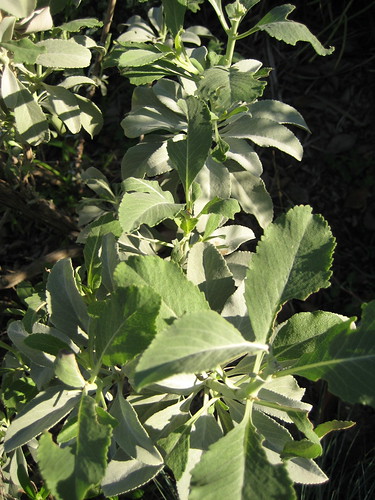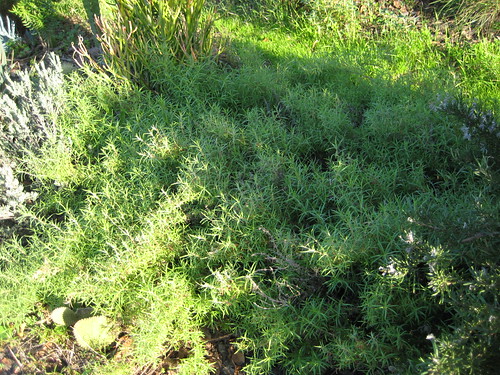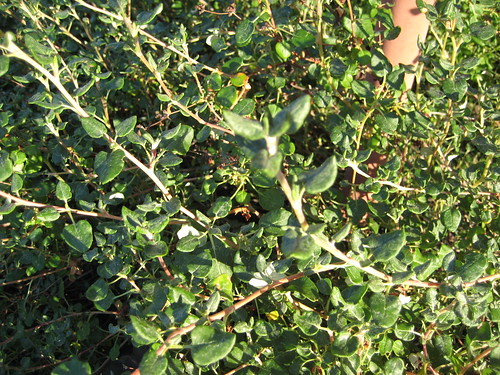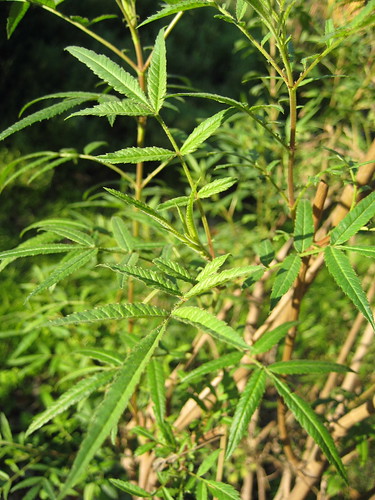I was happy to get this chart, because I've been wondering how well we've been conserving water, especially since our recently-planted fruit trees require more deep and frequent watering than most of our other landscaping. When I looked at the chart, I was delighted.
For a lot that's less than 7,499 square feet, the median winter water use, measured in HCF (hundred cubic feet), for a 2-month period is 24. Our water use for the last two months was 6 HCF. That's a quarter of the typical amount. My first reaction was, "Yippie!" My second reaction was, "Dang, how do people using the median amount afford their water bills?" I love it when caring about the environment translates into saving money. So often, it's the other way (i.e. buying organic or fair trade).
Dakota and I discussed why we manage to be so far under the median for water use, when, honestly, I don't feel like we work that hard at saving water. Obviously, part of it is that there are only two of us. But I don't think that can account for all of our water saving. Here are some factors I think help quite a lot:
1) Front-loading washer
Two summers ago, we got a new front-loading washer. It uses less water (and power) than a top loading washer, and less soap. I love it.
2) Low-flow shower head
When I moved into my house, I almost immediately installed a low-flow shower head. It's such an easy way to save water, especially when you're a big fan of hot showers. Gone are the days when a low-flow shower head meant an annoyingly low-pressure bathing experience. These days, water-saving shower heads make your pressure better, not worse. At least, that's what happened at my house. Almost six years later, our Earth Massage Showerhead is still going strong. It makes a big difference for us because Dakota usually takes two showers a day: one to wake up and one to clean off the sawdust after work. Both are vital to his happiness.
3) Toilet policy
In addition to having a low-flow toilet, like most houses in Los Angeles, we tend to not flush after every trip to the bathroom. No need to get into details, but I believe many hippies have signs in their bathroom beginning with the phrase, "If it's yellow, leave it mellow..." We don't have that sign, but we agree with the principle. Treehugger calls it the "Selective Flush." Some people are kind of grossed out by this idea, but it's how I grew up, so it seems completely natural to me.
4) Lawnless living
The single biggest water savings for us, I'm guessing, comes from our lack of a grass lawn. When I moved into the house back in 2003, there was a small lawn in the front, but Dakota and I took it out pretty quickly. In its place, we planted a mixture of California native plants, other low-water-use bushes and cacti. Now that the plants are established, they need very little water to flourish. I honestly can't remember the last time I watered the front yard. It's definitely been at least three months. We have a similar landscaping plan in the back, although obviously the vegetable garden and fruit trees do require watering several times a week. Still, I think our lawnless lot is what keeps our water bill so low.
I love our California native plants, too. Here are a few that have thrived over the years, despite intense dry heat and bad soil.

White sage. Has a very sage-y smell. The leaves are a really pretty pale green.

California fuschia. This one spreads sideways and has bright red flowers, which attract butterflies and hummingbirds.

Needle's buckwheat. This produces little white puffy flowers and grows like crazy. I'm constantly cutting it back. We have two varieties of buckwheat in the yard, the other is Red buckwheat.

I can't remember the name of this one. It blooms yellow, daisy-like flowers and the leaves have a wonderful, herbal smell. It also grows nicely from cuttings. I have two more bushes in the backyard from cuttings from this plant.
Basically, we make almost no sacrifices in order to keep our water use low. We still take showers when we want and have a clothes washer and a dishwasher. I certainly put some back-breaking labor into getting the front yard plants established, but now that they're in, they require almost nothing from me. It's nice to know saving water can be fairly easy. Pretty soon, it'll likely be a requirement for living in Southern California. Maybe once the city is done giving out CFLs they'll move on to low-flow shower heads and cacti.


We love having no lawn and lots of California natives, too. Besides saving water, we never have to use pesticides on these tough plants that are well-suited to their environment.
Hey! Nice pics of indig. plants. I also really, really appreciate the low flow shower head suggestion. When we moved in to our place, I ripped the low flo out, and thought I'd have to sacrifice pressure for the environment (never!). So glad to know for the low, low price of 15 bucks, I don't! Also, I'm planting tomatoes dammit! You inspire. - Susan
There are dozens of little things we can all do to save water. If you go to http://www.bewaterwise.com/tips01.html you will see a water saving tips page that lists Indoor and Outdoor tips and how much water is saved with each one. Things like taking shorter showers saves 5 gallons a day, and installing a smart sprinkler controller saves 40 gallons per day! Check out all the tips on the site and pass it on to fellow Southern Californians!
And don't forget: cut the top off empty gallon plastic milk jugs--leaving the handles. Put one in the shower, one near each sink. When you are running hot water until it is warm, run it into the jug. You will find that unless your water heater is right next to the sink/shower, you will easily fill up a jug before it gets warm enough. Use this water, which would have been wasted, to water plants, indoors and out! The handles make them easy to carry and pour. A gallon saved is a gallon saved!
i think that last plant might be a tagetes lemonii? a type of marigold. very drought tolerant. i have one too and i love the smell!
love your blog by the way. we share many of the same values. we have chickens for eggs, and have planted natives all over our 1/2 acre property here in san diego. our 2-month use is generally between 10-15 HCF, which is way lower than others on a similar sized lot (1/2 acre is 21,000 square feet).
I just googled "tagetes lemmonii" and you're right. I think when I bought it they called it a Copper Canyon Daisy. Thanks for the ID blownaway!
yup, copper canyon daisy is another name for it. we've actually used this as an herb on baked salmon. pretty good, but go easy on it. it's quite strong!